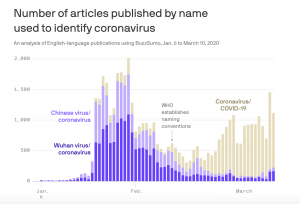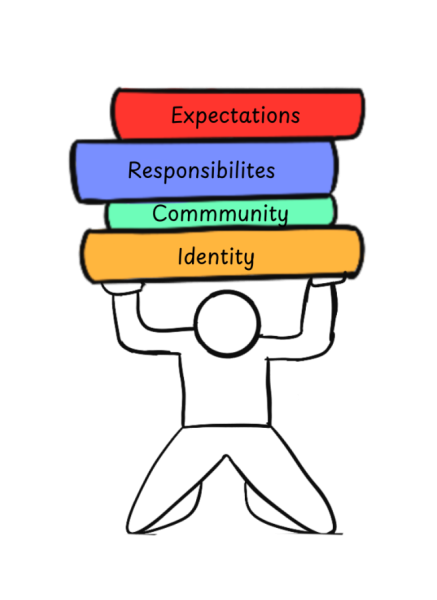The Impatient Patient: Mislabeling the coronavirus is counterproductive during a pandemic
Before the “Wuhan virus,” Wuhan, capital of China’s Hubei province, was more commonly associated with its Yellow Crane Tower and its signature dish — re gan mian or hot dry noodles.
Today, it is noted more as the epicenter of the coronavirus outbreak, and is increasingly being referred to as the “Wuhan virus,” “Chinese coronavirus” and “foreign virus,” despite the World Health Organization’s (WHO) discouragement of such practice. According to WHO guidelines, attaching a geographic location in naming a disease stigmatizes individuals of Chinese ancestry.
However, this has not deterred numerous political officials from misnaming the virus. Although the above mentioned phrases were used widely in the initial reports of the virus, news outlets stopped this practice when WHO introduced the terminology of “COVID-19” in reference, according to Axios.
The coronavirus originated in Wuhan, China. That is an undisputed fact. However, we need to understand the deeper implications of simply relegating it as a “foreign” and “Chinese” virus. In doing so, we create a sense of “otherness” when the virus has deep impacts for many countries not just in Asia.
Particularly, President Donald Trump has repeatedly referred to the virus as a “foreign” and “Chinese” virus, according to Forbes. On the surface, such a reference may not be a cause for concern: after all, according to Andrew McCarthy for The Hill, there is a long practice of naming diseases after their country of origin.
However, even with WHO’s explicit statement, using the incorrect terminology is not a “mistake,” but ignorant and a pointed political message.
Naming a disease after its geographical origin is more than a matter of convenience
The controversy surrounding the verbiage of the virus is not an issue of partisanship. The issue of misnaming a virus are the real-life effects it has on Asian people across the globe.

Continually misnaming the virus after WHO’s guidelines is ignorant
Language matters: according to Axios, Sec. of State Mike Pompeo’s use of “Chinese coronavirus” on CNBC and Fox and Friends led to an 800 percent increase in the phrase. And in political discourse, words used implicitly or explicitly express some political viewpoint, according to Ampere Translations.
The habit of naming a disease after its geographical origin is not just a matter of convenience, but a means of shifting blame during hysteria. According to Susan Sontag, most noted for her essay “Illness as a Metaphor,” Syphilis is a prime case of “the need to make a dreaded disease foreign.” To the English, it was the “French pox” and to the Japanese, the “Chinese disease.”
More than a matter of convenience it is also a matter of politics.
In the 1850s, there was an influx of Chinese immigrants due to a need for labor in the U.S. However, when the influx of immigrants began to threaten American job prospects, rumors arose that the Chinese were “disease vectors,” according to Doug Chan, president of the Chinese Historical Society of America and Marie Myung-Ok Lee, writer in residence at Columbia University’s Center for the Study of Ethnicity and Race.
And, when an outbreak of smallpox occurred in San Francisco, some 30,000 Chinese became “medical scapegoats,” with Chinatown blamed for being a “laboratory for infection.” According to Chan, those living in Chinatown were forcibly administered vaccines that had not been fully tested.
Associating an entire ethnic group to a virus has real and painful consequences
In a time of pandemic, where we worry about our health, our loved ones and a disrupted life, I argue that it is not only easy, but human to have misdirected anger. After all, since we have the misdirected convenience to trace the link of events back to an entity — such as Wuhan, China — we end up making it more than an epicenter but a place of blame. When we see Wuhan as the place that puts us in a pandemic, it makes it harder to see the people suffering in the city, whose place of home will forever be drastically different and continually disparaged.
By attaching China, Chinese people and Wuhan to a virus with an intent to produce a negative connotation, the line between interchanging negative feelings concerning the virus and the people and place associated with it narrows. When we mix a virus with a culture, it is those associated with the virus that ultimately bear the burden. For Chinese and non-Chinese people of Asian ancestry worldwide, the rising xenophobia is undoubtedly felt.
For example, Jonathan Mok, from Singapore, was beaten up by four men in London on Feb. 24. These men told Mok that they did not want “his coronavirus in [their] country,” according to Time. As a result of the attack, Mok may require surgery due to a broken bone near his right eye.
It is important to note that Mok is from Singapore, a country that is 2,133 miles away from Wuhan. The motives of the attack were not Mok’s place of origin, but the fact that his Asian heritage is now attached to a “foreign” virus.
Mok does not have ownership or responsibility for the coronavirus, yet that was the basis of his attack. While we cannot speculate if his attack is a result of the misnomer of the virus, what we can learn from his attack is that associating an entire ethnic group to a virus has real and painful consequences.
To connect the world’s largest ethnic group to a virus is ignorant. A billion Chinese people — 50 million of whom live overseas — do not all have a connection to Wuhan, one of China’s 686 cities.
Mok’s attack is not an isolated case. A Vietnamese art curator was withdrawn from an art fair as her presence could have caused “uneasiness” to the attendees, as Asians are seen as “the carriers of the disease.” In a New York subway, an Asian-American man was sprayed with air freshner by another passenger, which is now being investigated as a possible hate crime.
As Ho-Fung Hung, sociology professor at Johns Hopkins University said: “The virus itself doesn’t know ethnic boundaries. So if you are stuck with this perception that only certain groups of people you need to keep a distance from, you miss the more important part of keeping distance from other potential carriers.”











